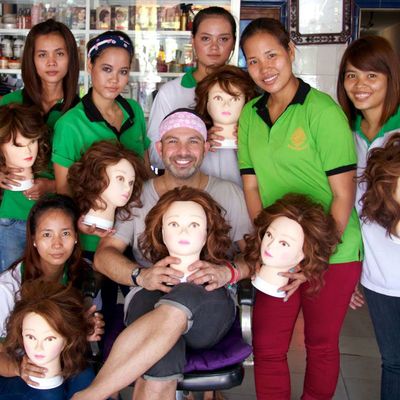
Michael Angelo stands in the Wonderland Beauty Parlor, a swarm of mermaid Barbies hanging overhead. Angelo, who owns the quirky Manhattan salon catering to fashion-y clients such as Brooklyn Decker and Lydia Hearst, has just returned from another salon — a simpler place on a dusty city street in Cambodia. There, he helps teach former sex slaves the art of hairdressing.
The young women, escapees from brothels in a country rife with human trafficking, are learning to support themselves in life outside the sex trade. Kidnapped or tricked into slavery as children, they were rescued with the help of another survivor, Somaly Mam, who runs shelters and job-training programs around the country.
Angelo arrived at the salon, located on a busy intersection in Phnom Penh, in late April with a colleague, Annastasia Konidaris, and armfuls of hairdryers and curling irons. “Some of the girls had never held a pair of scissors,” he says. “It was like I was Santa Claus.” He had first heard about the young survivors in 2006 through a client at his own salon, Czech model Veronica Varekova, who had seen Mam speak at an event and couldn’t wrap her head around the idea of children being sold for sex. Angelo “went home and Googled,” he says, and saw a photo of a girl in a brothel that “haunted” him. Her eyes were hollow, her lips red. “I always thought women wore lipstick because they love it — that’s the culture we grew up in.”
Slavery is big business globally, not just in Cambodia. An estimated 27 million people are current victims worldwide, according to the U.S. State Department. In Cambodia, a desperately poor country still reeling from the genocide of the Khmer Rouge, toddlers can be sold into the sex trade. Virgins command a high price — as much as $4,000, according to the State Department’s 2010 Trafficking in Persons Report. Local men as well as foreigners serve as clients, with the locals often driven by myths that sex with a virgin brings luck or health.
Angelo decided to travel to Phnom Penh in 2006 to meet Mam and discuss ways he could help. Instantly, she was a vivacious wisecracker who asked him how to put glitter on her eyelids, then immediately put him to work. “She asked me: ‘Do you know how to make a haircut?’” Angelo says. Suddenly he found himself teaching hairdressing to former sex slaves as part of a new job-training program she had launched. He wondered how his young students, who had been brutalized in unthinkable ways by men — beaten, whipped, chained — would react to their new male teacher. He was surprised to find that “they were wildly sweet,” he says.
The young women asked if he had chosen a wife. In fact, he had chosen a husband, but the law in New York at that time didn’t allow him to wed. So the women threw him and his partner, Scott MacDougall — a theology Ph.D. candidate who had traveled to Cambodia too — a makeshift wedding at a shelter on the rural outskirts of the city of Kampong Cham. “They walked us through a rice paddy,” Angelo says. “They put white flowers in our hair.”
His trip this month was his third. Dripping with sweat (“it was five billion degrees”), he taught 29 young women, ages 16 to 22, to do makeup and hair. He stressed subtlety with makeup, he says, not the heavy, “hit-by-a-truck” approach, a term that “made them laugh their heads off.”
The goal of the workshop: to give the women skills to work in a salon or to launch one of their own. The Phnom Penh salon is owned by a survivor of sex slavery named Neang Hok. She hires other survivors, and the salon is a self-sustaining business. Mam’s group runs hairdressing workshops in both Phnom Penh and Siem Reap, the town near the temples of Angkor Wat. The group is currently building a salon in Siem Reap, which will be run by survivors, catering to both local clients and tourists.
Mam, who is in her early forties and escaped the sex trade as a young woman, rescues the girls by winning their trust. She and her activists gain access to the brothels by bringing supplies such as condoms and soap. Then they tell the girls they can escape. The girls sometimes need convincing, as they are unsure they can survive in the outside world. The activists build a relationship over time, then work with trafficking officials to stage a rescue. The girls often report unfathomable abuses, such as being locked up in cages and coffins, covered with biting insects.
The young trainees speak varying amounts of English, so Angelo taught through demonstration. He recalls a poignant moment when a 16-year-old trainee volunteered to sit for a lesson on how to apply subtle makeup. One of the young observers suggested he create a “sexy eye,” he says, a request he chose to decline, feeling uncomfortable with it.
Angelo, 42, worked at a salon in a strip mall in New Jersey for six years after high school, eventually becoming “a big fish in a small pond” and moving to Manhattan. He worked in various salons around the city before opening Wonderland in 2006, in the meatpacking district, where he has watched the post–Sex and the City–ification of the neighborhood around him. He keeps going back to Cambodia, he says, because it helps him keep the “stupid and superficial” world of beauty in perspective. “The things I learn there are so much bigger than what I teach.”
About this photo: Michael Angelo with salon owner and slavery survivor Neang Hok (second from right) and helpers including a fellow survivor (far left) and at-risk girls.